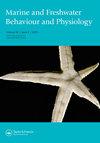短尾蟹代谢率的生态和进化驱动因素的荟萃分析
IF 1.1
4区 生物学
Q3 MARINE & FRESHWATER BIOLOGY
Marine and Freshwater Behaviour and Physiology
Pub Date : 2018-03-04
DOI:10.1080/10236244.2018.1474714
引用次数: 14
摘要
代谢率提供了对不同生物的生活成本的估计,可以很容易地跨物种进行比较,以提供对其相对生存需求的估计。因此,代谢率已经测量了几十年的范围广泛的生物体。在这里,我们回顾了已发表的对短爪蟹代谢率的估计,短爪蟹是一种普遍存在的、在生态和经济上都很重要的消费群体。在控制了系统发育关系后,螃蟹的代谢率与体重呈比例关系,其比例指数为0.65,这与许多其他动物群体的生态学理论和结果一致。同样,与其他类的变温动物一样,螃蟹的代谢率随着温度的升高而急剧增加,Q10为1.26。此外,我们发现代谢率与生态位相关,随饮食策略和栖息地占用而变化。这些结果有助于阐明施加代谢压力的环境变化对螃蟹的相对风险,包括气候变化和缺氧区的扩散。本文章由计算机程序翻译,如有差异,请以英文原文为准。
A meta-analysis of the ecological and evolutionary drivers of metabolic rates in brachyuran crabs
Abstract Metabolic rates provide an estimate of the cost of living for different organisms that can readily be compared across species to provide an estimate of their relative requirements for survival. As such, metabolic rates have been measured for decades on a wide range of organisms. Here, we review published estimates of metabolic rates for brachyuran crabs, a ubiquitous and ecologically and economically important group of consumers. Consistent with ecological theory and results in many other groups of animals, and after controlling for phylogenetic relationships, crab metabolic rates scale with body mass with a scaling exponent of 0.65. Similarly, as with other groups of poikilotherms, crab metabolic rates increase strongly with temperature, with a Q10 of 1.26. Additionally, we found that metabolic rates were correlated with ecological niche, varying with both the diet strategy and the habitat occupied. These results help clarify the relative risk to crabs from environmental changes that impose metabolic stress, including climate change and the proliferation of hypoxic zones.
求助全文
通过发布文献求助,成功后即可免费获取论文全文。
去求助
来源期刊

Marine and Freshwater Behaviour and Physiology
生物-海洋与淡水生物学
CiteScore
2.10
自引率
0.00%
发文量
9
审稿时长
>12 weeks
期刊介绍:
Marine and Freshwater Behaviour and Physiology is devoted to the publication of papers covering field and laboratory research into all aspects of the behaviour and physiology of all marine and freshwater animals within the contexts of ecology, evolution and conservation.
As the living resources of the world’s oceans, rivers and lakes are attracting increasing attention as food sources for humans and for their role in global ecology, the journal will also publish the results of research in the areas of fisheries biology and technology where the behaviour and physiology described have clear links to the contexts mentioned above.
The journal will accept for publication Research Articles, Reviews, Rapid Communications and Technical Notes (see Instructions for authors for details). In addition, Editorials, Opinions and Book Reviews (invited and suggested) will also occasionally be published. Suggestions to the Editor-In-Chief for Special Issues are encouraged and will be considered on an ad hoc basis.
With the goal of supporting early career researchers, the journal particularly invites submissions from graduate students and post-doctoral researchers. In addition to recognising the time constraints and logistical limitations their research often faces, and their particular need for a prompt review process, accepted articles by such researchers will be given prominence within the journal (see Instructions for authors for details).
 求助内容:
求助内容: 应助结果提醒方式:
应助结果提醒方式:


